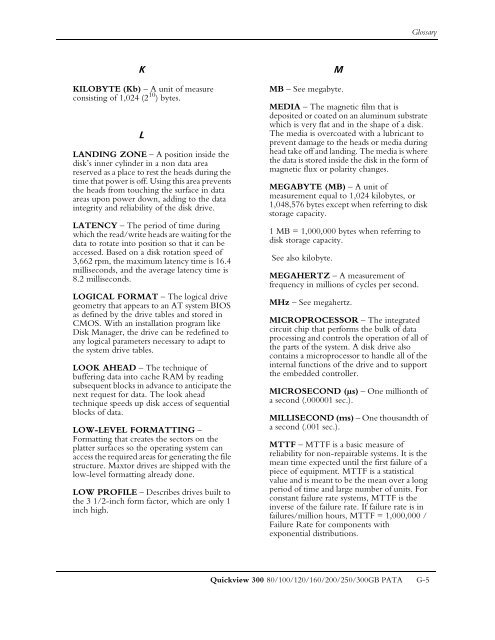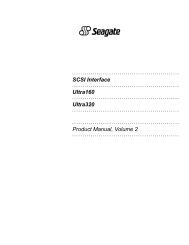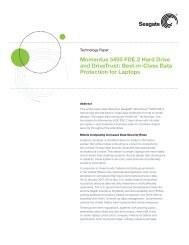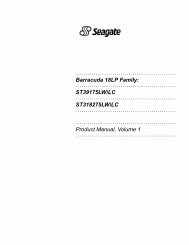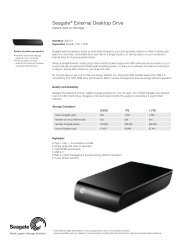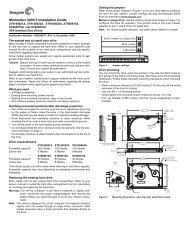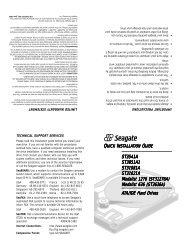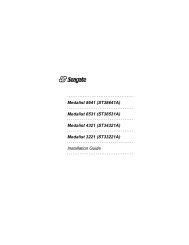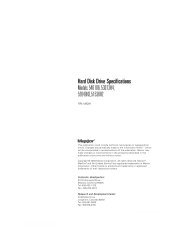Quickview 300 Product Manual PATA - Seagate
Quickview 300 Product Manual PATA - Seagate
Quickview 300 Product Manual PATA - Seagate
Create successful ePaper yourself
Turn your PDF publications into a flip-book with our unique Google optimized e-Paper software.
Glossary<br />
K<br />
KILOBYTE (Kb) – A unit of measure<br />
consisting of 1,024 (2 10 ) bytes.<br />
L<br />
LANDING ZONE – A position inside the<br />
disk’s inner cylinder in a non data area<br />
reserved as a place to rest the heads during the<br />
time that power is off. Using this area prevents<br />
the heads from touching the surface in data<br />
areas upon power down, adding to the data<br />
integrity and reliability of the disk drive.<br />
LATENCY – The period of time during<br />
which the read/write heads are waiting for the<br />
data to rotate into position so that it can be<br />
accessed. Based on a disk rotation speed of<br />
3,662 rpm, the maximum latency time is 16.4<br />
milliseconds, and the average latency time is<br />
8.2 milliseconds.<br />
LOGICAL FORMAT – The logical drive<br />
geometry that appears to an AT system BIOS<br />
as defined by the drive tables and stored in<br />
CMOS. With an installation program like<br />
Disk Manager, the drive can be redefined to<br />
any logical parameters necessary to adapt to<br />
the system drive tables.<br />
LOOK AHEAD – The technique of<br />
buffering data into cache RAM by reading<br />
subsequent blocks in advance to anticipate the<br />
next request for data. The look ahead<br />
technique speeds up disk access of sequential<br />
blocks of data.<br />
LOW-LEVEL FORMATTING –<br />
Formatting that creates the sectors on the<br />
platter surfaces so the operating system can<br />
access the required areas for generating the file<br />
structure. Maxtor drives are shipped with the<br />
low-level formatting already done.<br />
LOW PROFILE – Describes drives built to<br />
the 3 1/2-inch form factor, which are only 1<br />
inch high.<br />
M<br />
MB – See megabyte.<br />
MEDIA – The magnetic film that is<br />
deposited or coated on an aluminum substrate<br />
which is very flat and in the shape of a disk.<br />
The media is overcoated with a lubricant to<br />
prevent damage to the heads or media during<br />
head take off and landing. The media is where<br />
the data is stored inside the disk in the form of<br />
magnetic flux or polarity changes.<br />
MEGABYTE (MB) – A unit of<br />
measurement equal to 1,024 kilobytes, or<br />
1,048,576 bytes except when referring to disk<br />
storage capacity.<br />
1 MB = 1,000,000 bytes when referring to<br />
disk storage capacity.<br />
See also kilobyte.<br />
MEGAHERTZ – A measurement of<br />
frequency in millions of cycles per second.<br />
MHz – See megahertz.<br />
MICROPROCESSOR – The integrated<br />
circuit chip that performs the bulk of data<br />
processing and controls the operation of all of<br />
the parts of the system. A disk drive also<br />
contains a microprocessor to handle all of the<br />
internal functions of the drive and to support<br />
the embedded controller.<br />
MICROSECOND (µs) – One millionth of<br />
a second (.000001 sec.).<br />
MILLISECOND (ms) – One thousandth of<br />
a second (.001 sec.).<br />
MTTF – MTTF is a basic measure of<br />
reliability for non-repairable systems. It is the<br />
mean time expected until the first failure of a<br />
piece of equipment. MTTF is a statistical<br />
value and is meant to be the mean over a long<br />
period of time and large number of units. For<br />
constant failure rate systems, MTTF is the<br />
inverse of the failure rate. If failure rate is in<br />
failures/million hours, MTTF = 1,000,000 /<br />
Failure Rate for components with<br />
exponential distributions.<br />
<strong>Quickview</strong> <strong>300</strong> 80/100/120/160/200/250/<strong>300</strong>GB <strong>PATA</strong> G-5


